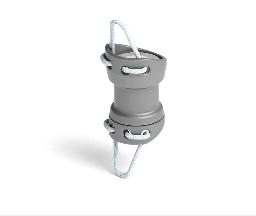There are many types of swivels used on board boats, several of which are mounted on halyards, however, the term “Halyard Swivel” is reserved for one specific application. In this blog we will explain what a halyard swivel is, what it does and then explain the options available, depending on the setup of your boat.
What is a halyard swivel?
A halyard swivel is used at the head of the majority of furling sails. It allows for a fixed halyard on a furling sail.
This is achieved by using an independent swivel link between the halyard shackle and head of the sail which prevents the halyard from wrapping around the forestay during furling.
Unlike many other types of swivels used on-board, the halyard swivel encapsulates the forestay or furling foil. This provides a fixed point for attachment of the head of the sail when in use, and it controls the head of the sail during hoisting and lowering.
Halyard Swivel Types
There are 3 main styles of halyard swivels based on the type of furling system being used: Genoa reefing, big boat structural furlers and small boat wire furlers.
Genoa reefing furlers
Traditional Genoa reefing furlers are distinguishable by the aluminium foil sections which encase the main forestay along its full length. Halyard swivels on these systems are designed to be installed and slid up and down the aluminium foil section.


Image Credits: Harken/Facnor
Structural furlers
Structural furlers differ from genoa reefing furlers because the forestay itself is an integral part of the furling system. The forestay is attached to the furling drum at the bottom, and a swivel at the top; the sail furls directly around the stay.
Composite stay
A modern system based on technology developed from code zero torsional composite cables.
On yachts with wire diameters of >=10mm, structural furling cables are almost exclusively made of composite materials. Because composite cables are built to custom diameters, there are a limited number of standard halyard swivels available on the market.
The halyard swivel has to be permanently fitted to the cable during manufacture and before the ends of the cable are terminated. The vast majority of structural furlers, on composite stays, are used on race boats and due to the complications of installation, the majority of race campaigns chose to lash the sail to the cable (at the head) and forego the option to hoist/lower the sail.


Image Credits: Karver / Reckmann
Wire stays
Jib furlers on dinghy’s have been around for generations and are a form of structural furler, as the jib rolls directly around the wire forestay. There are a large range of halyard swivel options available for wire diameters from 3mm – 8mm. As with composite stays, the halyard swivel must be permanently installed on the wire prior to installing the end fittings. However, when these can be quickly swaged onsite, it is a relatively simple operation.


Image Credits: Facnor/Harken
The Facnor drawing above clearly shows the location of the halyard swivel on a structural wire furler setup; mounted on the forestay in between the drum at the lower end and the upper swivel. It allows the sail to be hoisted and lowered, like any other head sail.
Finally, there is an interesting hybrid, small boat, option from Ronstan where the halyard swivel does not encase the forestay. Instead it uses a guide which holds the swivel in position behind the stay. This allows the use of a furling system which is completely independent of the wire forestay. The compromise is that, due to the drum diameter, this significantly reduces the usable sail area.


Image Credits: Ronstan
Summary on Halyard Swivel
Whether it is mounted on foils, composite or wire forestays, the halyard swivel has 2 important functions:
- It allows the sail to be furled whilst using a standard, fixed halyard setup.
- It creates a fixed point for the head of the sail against the forestay and allows the sail to be hoisted and lowered.
If you have any questions about furlers, please feel free to email us at [email protected], or click the link below to see our full range:


Is it a Halyard Swivel, Top Swivel or just a Swivel!?